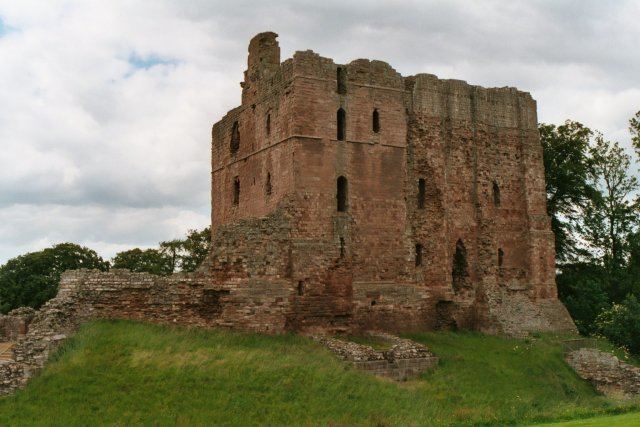Spouse(s) Margaret de Presfen Parents Thomas Grey Name Thomas Grey | Role Author Books Scalacronica Died 1369 | |
 | ||
Grandchildren John Grey, 1st Earl of Tankerville Great grandchildren Henry Grey, 2nd Earl of Tankerville | ||
Children Sir Thomas Grey of Heaton | ||
Sir Thomas Grey or Gray (d. before 22 October 1369) of Heaton near Norham, Northumberland, was the son of Sir Thomas Grey, an eminent soldier in the Anglo-Scottish wars in the reigns of Edward I and Edward II, and his wife, Agnes de Bayles. He was the author of the English chronicle, the Scalacronica.
Contents
Family
Sir Thomas Grey, author of the Scalacronica, was the son of Sir Thomas Grey of Heaton (d. before 12 March 1344) and his wife Agnes de Bayles.
Grey had four sisters, who according to King married John de Eure, William de Felton, William Heron, and Gerard Salvayn, 'all eldest sons of prominent knightly families'.
Grey's father served almost continuously during the Anglo-Scottish wars in the reigns of Edward I and Edward II. In May 1297 Grey's father was left for dead on the field when William Wallace attacked Lanark, killing the English sheriff, William de Heselrigg, but recovered, and was active in various campaigns in the ensuing years. In May 1303 the elder Grey was captured by the Scots at Melrose Abbey, and after his release was at the siege of Stirling Castle the following spring, where he effected a dramatic rescue of Henry de Beaumont, with whom he was closely associated for much of his career. Later, at the Bannockburn, Grey's father was taken prisoner by the Scots in a skirmish on 23 June 1314, the day before the main battle. He was constable of Norham Castle from 1319 to 1331, resisting two lengthy Scottish sieges there, and appears to have died shortly before 12 March 1344.
Career
Grey had already been knighted before his father's death, and according to King, likely served in Scotland alongside his father in the 1330s, and may have had his first experience of war in August 1332 as part of a private expedition into Scotland mounted by a group of noblemen and gentry known as the 'Disinherited', which culminated in a battlefield victory at Dupplin Moor.
In June 1338 he took out letters of protection to accompany William Montagu, 1st Earl of Salisbury on a military expedition to Flanders, and in 1340 served on the Scottish Marches.
In March 1344 'in consideration of his good service beyond the seas as well as within', he was made warden of the manor of Middlemast Middleton in Coquetdale, which had come into the King's hands by forfeiture, and was also the recipient of several other smaller grants. On 8 January 1345 he was appointed Constable of Norham Castle, and on 10 April of that year had livery of the family manor of Heaton. According to King, Grey also acquired a great deal of additional land, and left his estate much better than he found it, and was likely the builder of Heaton Castle.
In 1345 he received letters of protection to accompany an expedition to Sluys, which ultimately came to nothing, and in October 1346 fought at the Battle of Neville's Cross, for which he and others received personal letters of thanks from King Edward III.
In August 1355, during a sally from Norham Castle, he and one of his sons were captured at Nesbit by the Scots following the Battle of Nesbit Muir.
Grey was taken prisoner in late 1355 and held captive at Edinburgh Castle, and before 25 November 1356 wrote to King Edward III pleading for help in paying his ransom. He had been released by 15 August 1357, and in October 1357 was given custody of John Gray, one of the hostages for the ransom of King David of Scotland. According to Archer, in August 1359 Grey is thought to have accompanied King Edward's eldest son and heir, Edward, the Black Prince, to France. Grey was made Warden of the East Marches in October 1367, and is thought to have died some time before 22 October 1369.
The Scalacronica
While in captivity at Edinburgh, Grey started to write the Scalacronica, a chronicle in Anglo-Norman French in five parts, which relates both universal and English history from the earliest times. He was released in 1356 and continued to work on it back in England up until the year 1362. The chief historical value of the work is in the parts dealing with the reigns of King Edward I, King Edward II, and King Edward III which draw on the personal experience of both the author and his father as soldiers in the Anglo-Scottish and French wars during those reigns.
Marriage and issue
About 1353 Grey married Margaret de Presfen, the daughter and heiress of William de Presfen of Presson, Northumberland. They had at least one son and three daughters:
The chronicler's grandson, Sir Thomas Grey (30 November 1384 – 2 August 1415), was one of the principals in the Southampton Plot.
Shakespeare and Sir Thomas Grey
The quarrel between Grey's son-in-law, Thomas de Mowbray, 1st Duke of Norfolk, and Henry Bolingbroke, the future King Henry IV, is depicted in Act I of Shakespeare's Richard II.
